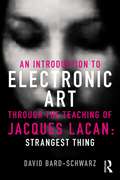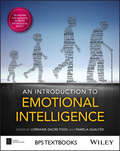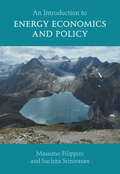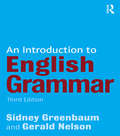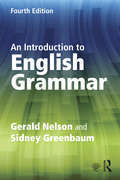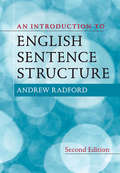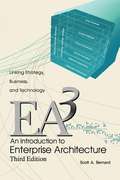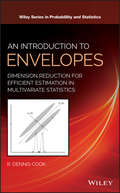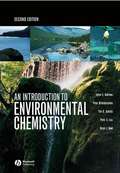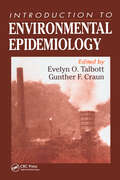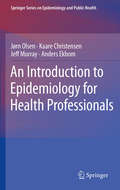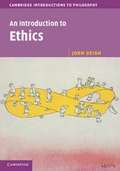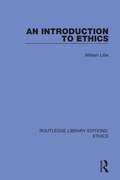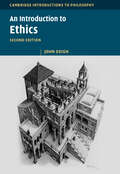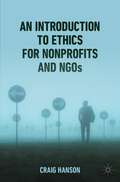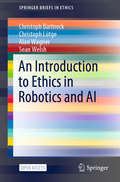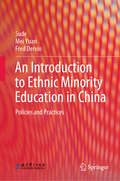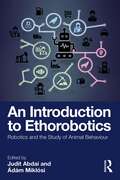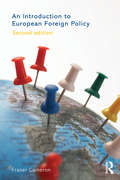- Table View
- List View
An Introduction to Electronic Art Through the Teaching of Jacques Lacan: Strangest Thing
by David Bard-SchwarzElectronic art offers endless opportunities for reflection and interpretation. Works can be interactive or entirely autonomous and the viewer's perception and reaction to them may be challenged by constantly transforming images. Whether the transformations are a product of the appearances or actions of a viewer in an installation space, or a product of a self-contained computer program, is a source of constant fascination. Some viewers may feel strange or unnerved by a work, while others may feel welcoming, humorous, and playful emotions. The art may also provoke a critical response to social, aesthetic, and political aspects of early twenty-first-century life. This book approaches electronic art through the teachings of Jacques Lacan, whose return to Freud has exerted a powerful and wide-ranging influence on psychoanalysis and critical theory in the twentieth century. David Bard-Schwarz draws on his experience with Lacanian psychoanalysis, music, and interactive and traditional arts in order to address aspects of the works the viewer may find difficult to understand. Dividing his approach over four thematic chapters—Bodies, Voices, Eyes, and Signifiers—Bard-Schwarz explores the links between works of new media and psychoanalysis (how we process what we see, hear, touch, imagine, and remember). This is a fascinating book for new media artists and critics, museum curators, psychologists, students in the fine arts, and those who are interested in digital technology and contemporary culture.
An Introduction to Electronic Warfare; from the First Jamming to Machine Learning Techniques
by Chi-Hao Cheng James TsuiSince its creation at the beginning of World II, radars have forever transformed the practice of modern warfare. The evolution of countermeasure conducted by electronic warfare systems against radars and radars’ corresponding counter countermeasures is an intriguing technical subject. This book provides a very accessible introduction to a broad range of radar and electronic warfare technologies. The subjects covered in this book range from early radar development to later technologies such as stealthy techniques, low probability of intercept radar, and machine learning. Historical events are used to illustrate the principles of electronic warfare and to help readers to apprehend contexts under which radars and corresponding electronic warfare techniques were developed.
An Introduction to Emotional Intelligence (BPS Textbooks in Psychology)
by Lorraine Dacre Pool Pamela QualterBridges the gap between the scholarly literature and “pop-psych” books on EI Emotional Intelligence (EI) has become a topic of vast and growing interest worldwide and is concerned with the ways in which we perceive, identify, understand, and manage emotions. It is an aspect of individual difference that can impact a number of important outcomes throughout a person’s lifespan. Yet, until now there were no authoritative books that bridge the gap between scholarly articles on the subject, often published in obscure professional journals, and the kind of books found in the “pop-psych” sections of most large bookstores. This book fills that gap, addressing the key issues from birth through to old age, including the impact of EI on child development, social relationships, the workplace, and health. It is a useful introduction to the academic study of EI, including its history as a concept. Featuring contributions by an international team of EI researchers, this thought provoking and informative book offers students, educators, mental health professionals, and general readers a comprehensive, critical, and accessible introduction to state-of-the-art EI theory and research. From the historical origins of EI to its contemporary applications across an array of domains, An Introduction to Emotional Intelligence explores what the research evidence tells us about it, why it is important, and how it is measured. Throughout each chapter any potentially tricky words or concepts are highlighted and explained. And, most chapters feature activities to spur further reflection on the subject matter covered as well as ideas on how to apply aspects of EI to various questions or problems arising in the readers’ lives. Features contributions from expert authors from around the world with experience of researching and teaching EI theory and practice Makes EI concepts, foundations, research, and theory accessible to a wider audience of readers than ever before Explores EI’s roots in psychological thinking dating back to early 20th century and considers the reasons for its widespread popularity in contemporary times Reviews the latest research into the constructs of ability EI and trait EI and their validity in relation to health, wellbeing, social relationships, academic, and work performance An Introduction to Emotional Intelligence is fascinating and informative reading and a source of practical insight for students of psychology, management and leadership, education, social work and healthcare, and those working in education, health settings and in psychological counseling professions.
An Introduction to Energy Diplomacy: China’s Perspective (Research Series on the Chinese Dream and China’s Development Path)
by Haiyun Wang Qinhua XuThis book discusses the basic and cutting-edge theories in the area of energy diplomacy in the global context, focusing on topics such as international dialogues on energy, government-directed partnerships, international energy games, the activities of international agencies, and public energy diplomacy. It also analyzes in detail the relationship between global energy diplomacy and international energy, while at the same time identifying the major problems of China’s energy diplomacy to provide a framework for the country’s energy diplomacy strategy—an essential component of China’s overall diplomatic strategy.
An Introduction to Energy Economics and Policy
by Massimo Filippini Suchita SrinivasanEnergy economics and policy are at the heart of current debates regarding climate change and the switch from fossil fuels to renewable forms of energy. They are also crucial in dealing with energy supply and security issues caused by global shocks such as the war in Ukraine. An Introduction to Energy Economics and Policy outlines pressing issues concerning current global energy systems, particularly energy production and use. It presents economic frameworks for valuating policy goals and for understanding the major energy and climate challenges faced by industrialized and developing countries. Integrating insights from behavioural economics into the standard neoclassical approach, particularly the role of behavioural anomalies, this book offers a novel introduction to energy economics and policy and provides a fresh perspective on real-world issues in energy and climate. This title is also available as open access on Cambridge Core.
An Introduction to English Grammar
by Sidney Greenbaum Gerald NelsonAn Introduction to English Grammar provides a comprehensive overview of all aspects of English grammar. The first part of the book ('The Grammar') provides a step-by-step introduction to the key topics in English grammar. The second part ('The Applications') shows how a grasp of these topics can be helpful in resolving usage problems, in developing a clear writing style, and in mastering punctuation and spelling. A whole chapter, 'English in Use', is devoted to illustrating the grammatical features of a wide range of modern text types, including emails, Facebook pages, and 'tweets'. It also looks at the special grammatical features of English in everyday conversation. Each chapter is followed by two sets of exercises. The first set can be used in self-study or in the classroom. The second set deals with more advanced topics, and can be used for classroom discussion or essay writing. This fourth edition has been fully revised and updated and includes: clearer descriptions and improved presentation new material on word structure and word formation new exercises, examples and extracts updated further reading Assuming no prior knowledge of English grammar, this book is ideal for beginning students on a one-semester course and provides everything a student needs on the theory and practice of English usage. A comprehensive Glossary of grammatical terms is included and a website provides invaluable additional exercises.
An Introduction to English Grammar
by Sidney Greenbaum Gerald NelsonAn Introduction to English Grammar provides a comprehensive overview of all aspects of English grammar. The first part of the book (‘The Grammar’) provides a step-by-step introduction to the key topics in English grammar. The second part (‘The Applications’) shows how a grasp of these topics can be helpful in resolving usage problems, in developing a clear writing style, and in mastering punctuation and spelling. A whole chapter, ‘English in Use’, is devoted to illustrating the grammatical features of a wide range of modern text types, including emails, Facebook pages, and ‘tweets’. It also looks at the special grammatical features of English in everyday conversation. Each chapter is followed by two sets of exercises. The first set can be used in self-study or in the classroom. The second set deals with more advanced topics, and can be used for classroom discussion or essay writing. This fourth edition has been fully revised and updated and includes: clearer descriptions and improved presentation new material on word structure and word formation new exercises, examples and extracts updated further reading Assuming no prior knowledge of English grammar, this book is ideal for beginning students on a one-semester course and provides everything a student needs on the theory and practice of English usage. A comprehensive Glossary of grammatical terms is included and a website provides invaluable additional exercises.
An Introduction to English Sentence Structure
by Andrew RadfordThis new edition of Andrew Radford's outstanding resource for students is a step-by-step, practical introduction to English syntax and syntactic principles, written by a globally-renowned expert in the field. Assuming little or no prior background in syntax, Radford outlines key concepts and how they can be used to describe various aspects of English sentence structure. Each chapter contains core modules focusing on a specific topic, a summary recapitulating the main points of the chapter, and a bibliographical section providing references to original source material. This edition has been extensively updated, with new analyses, exercise materials, references and a brand-new chapter on adjuncts. Students will benefit from the online workbook, which contains a vast amount of exercise material for each module, including self-study materials and a student answerbook for these. Teachers will value the extensive PowerPoints outlining module contents and the comprehensive teacher answerbook, which covers all workbook and PowerPoint exercises.
An Introduction to Enterprise Architecture (Third Edition)
by Scott A. BernardAn Introduction to Enterprise Architecture is the culmination of several decades of experience that Scott A. Bernard gained through work initially as an information technology manager and then as a consultant to executives in the public and private sectors. He wrote this book for three major reasons: (1) to help move business and technology planning from a systems and process-level view to a more strategy-driven enterprise-level view, (2) to promote and explain the emerging profession of EA, and (3) to provide the first textbook on the subject of EA, which is suitable for graduate and undergraduate levels of study. To date, other books on EA have been practitioner books not specifically oriented toward a student who may be learning the subject with little to no previous exposure. Therefore, this book contains references to related academic research and industry best practices, as well as Scott A. Bernard's own observations about potential future practices and the direction of this emerging profession.
An Introduction to Envelopes: Dimension Reduction for Efficient Estimation in Multivariate Statistics (Wiley Series in Probability and Statistics #401)
by R. Dennis CookWritten by the leading expert in the field, this text reviews the major new developments in envelope models and methods An Introduction to Envelopes provides an overview of the theory and methods of envelopes, a class of procedures for increasing efficiency in multivariate analyses without altering traditional objectives. The author offers a balance between foundations and methodology by integrating illustrative examples that show how envelopes can be used in practice. He discusses how to use envelopes to target selected coefficients and explores predictor envelopes and their connection with partial least squares regression. The book reveals the potential for envelope methodology to improve estimation of a multivariate mean. The text also includes information on how envelopes can be used in generalized linear models, regressions with a matrix-valued response, and reviews work on sparse and Bayesian response envelopes. In addition, the text explores relationships between envelopes and other dimension reduction methods, including canonical correlations, reduced-rank regression, supervised singular value decomposition, sufficient dimension reduction, principal components, and principal fitted components. This important resource: • Offers a text written by the leading expert in this field • Describes groundbreaking work that puts the focus on this burgeoning area of study • Covers the important new developments in the field and highlights the most important directions • Discusses the underlying mathematics and linear algebra • Includes an online companion site with both R and Matlab support Written for researchers and graduate students in multivariate analysis and dimension reduction, as well as practitioners interested in statistical methodology, An Introduction to Envelopes offers the first book on the theory and methods of envelopes.
An Introduction to Environment, Society and Sustainability
by Paul Sutton Helen HazenThis timely and innovative book delves into the complex interplay of human activities and natural limits in generating today’s sustainability challenges. By contrasting the pressures of growing populations with ecological footprints associated with consumption, the volume navigates the contested terrain where human societies generate environmental impacts.Adorned with illustrative figures, examples and case studies throughout, this book presents insightful analysis of ecological, economic, technological, and social justice responses to the challenges faced by human civilization, including land degradation, climate change, pollution, and overexploitation of natural resources. Many of these issues are wicked problems, characterized by incomplete information, multiple stakeholders, and contested approaches to addressing them. In simple terms, sustainability issues are an interplay between population growth and rising consumption, which are placing impossible demands on finite resources. Potential solutions to the crisis are split between green growth approaches that emphasize technology and institutional capacity to guide economic growth in more sustainable ways, and degrowth approaches that call for a fundamental rethinking of the way we structure society and generate value. This book emerged from a student seminar where undergraduate and graduate students highlighted sustainability topics of concern, helped consider their framing, and then assisted with co-writing several of the chapters. The volume encourages readers to consider structural questions that underpin sustainability dilemmas, and begins with four theoretical frameworks for understanding sustainability issues: ideas from the natural sciences, the population/consumption debate, economic frameworks, and ethical approaches. It then uses a systems approach to apply these theoretical ideas to complex global systems such as the atmosphere, oceans, and agriculture.This volume will be of pivotal interest to students, scholars and academics in the fields of environmental studies, environment and society, human geography and environmental geography, as well as those with an interest in these areas more generally.
An Introduction to Environmental Chemistry
by Tim D. Jickells Peter Brimblecombe Brian Reid Peter S. Liss Julian E. AndrewsThis introductory text explains the fundamentals of the chemistry of the natural environment and the effects of mankind's activities on the earth's chemical systems. Retains an emphasis on describing how natural geochemical processes operate over a variety of scales in time and space, and how the effects of human perturbation can be measured. Topics range from familiar global issues such as atmospheric pollution and its effect on global warming and ozone destruction, to microbiological processes that cause pollution of drinking water deltas. Contains sections and information boxes that explain the basic chemistry underpinning the subject covered. Each chapter contains a list of further reading on the subject area. Updated case studies. No prior chemistry knowledge required. Suitable for introductory level courses.
An Introduction to Environmental Epidemiology
by Gunther F. Craun Evelyn O. TalbottAn Introduction to Environmental Epidemiology covers the basics of environmental exposure, health, and disease. Written to be easily accessible to readers with no formal training in epidemiology or statistics, this practical introduction is an ideal text/reference for students and professionals in nursing, medicine, industrial hygiene, occupational and environmental health, and general environmental science. It provides a target-organ oriented presentation of environmental hazards, with detailed discussions of selected exposures such as asbestos, lead, radon, and indoor and outdoor air pollutants. Major topics covered include:
An Introduction to Epidemiology for Health Professionals (Springer Series on Epidemiology and Public Health #1)
by Anders Ekbom Jørn Olsen Kaare Christensen Jeff MurrayToday, the public worries about emerging diseases and rapid changes of the frequency of well known diseases like autism, diabetes and obesity making the word epidemic part of the general discussion. Epidemiology should therefore be a basic component of medical training, yet often it is undertaught or even neglected. Concise and readable while also rigorous and thorough, An Introduction to Epidemiology for Health Professionals goes beyond standard textbook content to ground the reader in scientific methods most relevant to the current health landscape and the evolution of evidence-based medicine--valuable keys to better understanding of disease process, effective prevention, and targeted treatment.
An Introduction to Equity Derivatives (Second Edition)
by Sebastien Bossu Philippe HenrotteWritten by the internationally respected academic/finance professional author team of Sebastien Bossu and Philipe Henrotte, An Introduction to Equity Derivatives is the fully updated and expanded second edition of the popular Finance and Derivatives. It covers all of the fundamentals of quantitative finance clearly and concisely without going into unnecessary technical detail. Designed for both new practitioners and students, it requires no prior background in finance and features twelve chapters of gradually increasing difficulty, beginning with basic principles of interest rate and discounting, and ending with advanced concepts in derivatives, volatility trading, and exotic products. Each chapter includes numerous illustrations and exercises accompanied by the relevant financial theory. Topics covered include present value, arbitrage pricing, portfolio theory, derivates pricing, delta-hedging, the Black-Scholes model, and more. An excellent resource for finance professionals and investors looking to acquire an understanding of financial derivatives theory and practice Completely revised and updated with new chapters, including coverage of cutting-edge concepts in volatility trading and exotic products An accompanying website is available which contains additional resources including powerpoint slides and spreadsheets. Visit www.introeqd.com for details.
An Introduction to Essential Algebraic Structures
by Leonid A. Kurdachenko Martyn R. Dixon Igor Ya SubbotinA reader-friendly introduction to modern algebra with important examples from various areas of mathematicsFeaturing a clear and concise approach, An Introduction to Essential Algebraic Structures presents an integrated approach to basic concepts of modern algebra and highlights topics that play a central role in various branches of mathematics. The authors discuss key topics of abstract and modern algebra including sets, number systems, groups, rings, and fields. The book begins with an exposition of the elements of set theory and moves on to cover the main ideas and branches of abstract algebra. In addition, the book includes:Numerous examples throughout to deepen readers' knowledge of the presented materialAn exercise set after each chapter section in an effort to build a deeper understanding of the subject and improve knowledge retentionHints and answers to select exercises at the end of the bookA supplementary website with an Instructors Solutions manualAn Introduction to Essential Algebraic Structures is an excellent textbook for introductory courses in abstract algebra as well as an ideal reference for anyone who would like to be more familiar with the basic topics of abstract algebra.
An Introduction to Ethics
by J. D. MabbottOriginally published in 1966, this introduction to moral philosophy examines the philosophical basis of moral problems and considers some of the crucial arguments that attempt to define or dispense with a moral justification of events. Some of the questions discussed are whether moral rules are justified and whether there is any positive evidence that man has free will.
An Introduction to Ethics
by John DeighThis book examines the central questions of ethics through a study of theories of right and wrong that are found in the great ethical works of Western philosophy. It focuses on theories that continue to have a significant presence in the field. The core chapters cover egoism, the eudaimonism of Plato and Aristotle, act and rule utilitarianism, modern natural law theory, Kant's moral theory, and existentialist ethics. Readers will be introduced not only to the main ideas of each theory but to contemporary developments and defenses of those ideas. A final chapter takes up topics in meta-ethics and moral psychology. The discussions throughout draw the reader into philosophical inquiry through argument and criticism that illuminate the profundity of the questions under examination. Students will find this book to be a very helpful guide to how philosophical inquiry is undertaken as well as to what the major theories in ethics hold.
An Introduction to Ethics
by William LillieOriginally published in 1948, and reprinted in 1955 and updated in 1961, this book is a straightforward account of moral philosophy for students. It discusses comprehensively the contributions made by 20th Century moralists, both in terms of the interpretation of their predecessors and original ethical speculation.
An Introduction to Ethics (Cambridge Introductions to Philosophy)
by John DeighNow in an expanded and revised second edition, this book offers clear, penetrating examination of the central questions of ethics through study of the most important ethical theories in Western philosophy. Readers are introduced not only to the main ideas of each theory but also to contemporary developments and defenses of those ideas. Among theories the book covers are egoism, the eudaimonism of Plato and Aristotle, act and rule utilitarianism, modern natural law theory, Kant's moral theory, and existentialist ethics. Two new chapters add to this coverage expositions of Hume's ethics, Sidgwick's program for defending utilitarianism, and Rawls's hypothetical contractarianism. The discussions throughout draw the reader into philosophical inquiry through argument and criticism that illuminate the profundity of the questions under examination. Students will find this book to be a helpful guide to how philosophical inquiry is undertaken as well as to what the major theories of ethics hold.
An Introduction to Ethics for Nonprofits and NGOs
by Craig HansonThis textbook explores ethical issues for not-for-profit and non-governmental organizations, providing discussion-oriented cases for NFP and NGP practitioners. The book begins with an introduction to professional ethics as practiced in industry, not-for-profits and NGO’s. Attention is paid both to classical ethical theories and contemporary variants. Then, combining that theory with an introduction to the morally unique facets of the NFP and NGO landscape, it offers a series of cases which pertain to the underlying theoretical substrate. The reader will find a blend of theory and application within the text as well as guided assignment prompts. Themes covered include board relationships, staff management, work with vulnerable populations, financial transparency, Human Resources ethics and ethical dilemmas unique to international operations.
An Introduction to Ethics in Robotics and AI (SpringerBriefs in Ethics)
by Alan Wagner Christoph Lütge Sean Welsh Christoph BartneckThis open access book introduces the reader to the foundations of AI and ethics. It discusses issues of trust, responsibility, liability, privacy and risk. It focuses on the interaction between people and the AI systems and Robotics they use. Designed to be accessible for a broad audience, reading this book does not require prerequisite technical, legal or philosophical expertise. Throughout, the authors use examples to illustrate the issues at hand and conclude the book with a discussion on the application areas of AI and Robotics, in particular autonomous vehicles, automatic weapon systems and biased algorithms. A list of questions and further readings is also included for students willing to explore the topic further.
An Introduction to Ethnic Minority Education in China: Policies and Practices
by Fred Dervin Sude Mei YuanChinese ethnic minority education is virtually unknown to readers outside China. Based on extensive qualitative and quantitative data, this book examines the basic education policies for ethnic minorities in China and describes policy implementation. It also discusses successful case studies, restrictive factors, existing gaps and challenges as well as the associated problems, highlighting teacher training and the role of policymakers. The authors propose recommendations to address the challenges faced by Chinese education, and to develop and implement culturally sensitive basic education for ethnic minorities in the country. Offering a rare glimpse inside minority schools in different parts of the country, the book appeals to educators, scholars, decision-makers and anyone interested in diversity education (intercultural, multicultural, global education).
An Introduction to Ethorobotics: Robotics and the Study of Animal Behaviour
by Ádám Miklósi Judit AbdaiThis pioneering text explores the emerging discipline of ethorobotics which brings together the fields of animal behaviour and robotics. It encourages closer collaboration between behavioural scientists and engineers to facilitate the creation of robots with a higher degree of functionality in animal/human environments and to broaden understanding of animal behaviour in new and intriguing ways.Utilising the knowledge of key ethologists and roboticists in the field today, this book is divided into four major parts. The first part is written for those with little or no background in the biology of animal behaviour, particularly for those coming from an engineering background seeking an accessible introduction to the field and how it can be applied to robotic behaviour. Topics include problem solving in animals, social cognition, and communication (visual, acoustic, olfactory, etc.). The second part is an introduction to the basic construction of robots for non‑engineers, and the possibilities offered by current technical achievements and their limitations to the study of animal behaviour. The third part explores the core theme of ethorobotics, the basic framework of the discipline, the field’s evolution, and current topics including ethical considerations, autonomy, to ‘living’ social robots. The fourth and final chapter looks at ethorobotics in practice through key research projects which have had the biggest impact.This is a ground‑breaking interdisciplinary text which will appeal to upper‑level undergraduates, postgraduates, and researchers focusing on animal behaviour and cognition, as well as those undertaking courses in engineering, social robotics, biologically inspired robotics, AI, and human–robot and animal–robot interactions.
An Introduction to European Foreign Policy
by Fraser CameronThis text is the best introduction to the history, institutions, actors, processes and challenges of European Foreign Policy. This 2nd edition has been fully revised and updated to reflect the substantial changes to European Foreign Policy as a result of the Lisbon Treaty and other significant changes in European and global politics. New material for this edition includes: detailed analysis of the changes brought about by the Lisbon treaty including the new High Representative of the Union for Foreign Affairs and Security Policy and the new EU External Action Service changing transatlantic relations since the election of President Obama expanded discussion of the European and Security Defence missions in Afghanistan, Kosovo and elsewhere an assessment of the impact of the relations between the EU and its three strategic partners – China, India and Japan –as well as ASEAN and the new FTA with Korea evaluation of the global financial crisis on the EU, examining EU’s external relations within the context of a rapidly changing global power structure. With clearly illustrated up-to-date case studies, covering major issues such as Egypt, Libya, Iraq and Iran, each chapter includes key questions and suggestions for further reading. As such, An Introduction to European Foreign Policy continues to be essential reading for all students of European and international politics as well as those who wish to become involved in the external relations of the EU.
